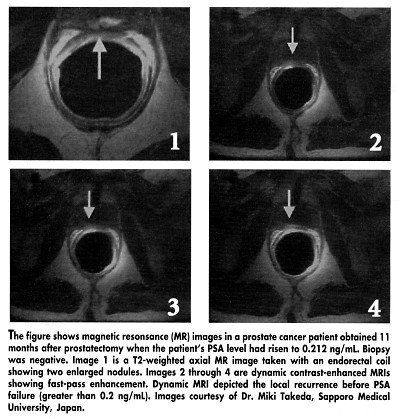MRI Finds Recurrences in Patients With Rising PSA Level
ATLANTA-Dynamic magnetic resonance imaging (MRI) may be able to detect recurrent prostate cancer after prostatectomy when the patient has a negative biopsy but a rising prostate-specific antigen (PSA) level.
ATLANTADynamic magnetic resonance imaging (MRI) may be able to detect recurrent prostate cancer after prostatectomy when the patient has a negative biopsy but a rising prostate-specific antigen (PSA) level.
This could potentially spare the patient the need for a second or third biopsy, said Miki Takeda, MD, a radiologist with Sapporo Medical University, Japan. She presented the findings at the 102nd Annual Meeting of the American Roentgen Ray Society (abstract 262).
According to Dr. Takeda, a rising PSA level following radical prostatectomy nearly always means recurrence of cancer. "In our hospital, about 30% of patients have rising PSA levels following radical prostatectomy," she said.
To test the ability of MRI to predict local recurrence, Dr. Takeda and her colleagues evaluated 21 patients with rising PSA levels who had undergone a radical prostatectomy. They examined the prostatic fossa with T2-weighted images. After a bolus injection of a gadolinium contrast agent, multisectional dynamic MR images were obtained every 10 to 15 second for 90 seconds (see Figure).

Although all patients had a negative ultrasound-guided biopsy, MRI suggested local recurrence in 17 of the 21 patients. "In most cases, a second or third biopsy would have been needed to confirm recurrence, and this takes timetime in which the patient’s PSA level may continue to rise," Dr. Takeda said.
Successful Treatment
Fifteen of the 17 patients with suggested local recurrence were treated with radiation therapy. PSA levels gradually declined in 10 of these patients after a 1-year follow-up period, and 7 were subsequently considered cancer free.
"Patients with a low PSA level or a small recurrent tumor before radiation therapy have a very favorable response to radiation," Dr. Takeda pointed out. "MRI has a high enough resolution to detect even a very small local recurrence as reflected by very low PSA levels."
Ultrasound cannot distinguish a fibrotic scar at surgery from a recurrent lesion, she said, but "early phase dynamic MRI can depict a suspicious lesion with first-pass enhancement and can be used in place of a second or third biopsy for any patient, which also lowers the risk of hemorrhage and infection."
In the past, Dr. Takeda said, the urologists in her hospital would hesitate to suggest that these patients undergo radiation therapy until their biopsies came back positive. "Now," she said, " the urologists recommend that these patients begin radiation therapy if their dynamic MR imaging examination indicates a cancer recurrence."
Prolaris in Practice: Guiding ADT Benefits, Clinical Application, and Expert Insights From ACRO 2025
April 15th 2025Steven E. Finkelstein, MD, DABR, FACRO discuses how Prolaris distinguishes itself from other genomic biomarker platforms by providing uniquely actionable clinical information that quantifies the absolute benefit of androgen deprivation therapy when added to radiation therapy, offering clinicians a more precise tool for personalizing prostate cancer treatment strategies.